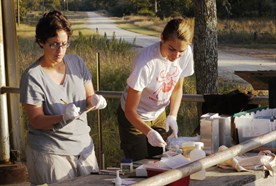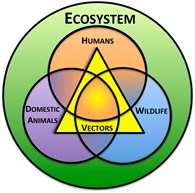

VIBS 413:
Introductory Epidemiology (Spring even years)
VIBS 413 Syllabus Spring 2018
Certificate in Public Health Entomology—Category III Course Option
Course Overview: As the interconnections among human health, domestic animal health, wildlife, and the environment are increasingly recognized in this ‘one health’ era, the breadth of epidemiology is deepening. Epidemiology is the study of the distribution and determinants of disease in populations and is distinguished from other medical disciplines in its focus at the population-level, and not individual level. Epidemiological principles guide the collection of data in the field and clinic, diagnostic laboratory protocols, statistical analyses, medical surveillance, and disease reporting. Epidemiology is the key science that guides public health policy and interventions. This course will train students to understand the concepts of epidemiology and fundamental tools used by epidemiologists, and how this field blends with other disciplines (ecology, human and veterinary clinical medicine, statistics, genetics, wildlife biology and more) to address some of society’s more pressing stressors.
VIBS 607:
Applied Epidemiology (Spring even years)
ENTO/VIBS 426/626:
Field and Lab Techniques in Vector-borne Disease Ecology (Spring odd years)
ENTO/VIBS 489/689 Syllabus Spring 2015
Certificate in Public Health Entomology—Capstone Course Option
Enrollment limited to 15 students: Graduate students, MPH students, and U3/U4 undergraduates.
Registration by application only.
Vector-borne diseases (VBDs) represent one of the fastest growing threats to human and animal population health. Patterns of climate change, global travel, urbanization, and species invasions suggest that VBDs will continue to challenge populations in both developed and developing countries. The One Health initiative calls for a synergy of efforts to protect human, animal, and ecosystem health, utilizing approaches from veterinary and human medicine, environmental science, and other disciplines. Because vectors and the pathogens they transmit often bridge humans, wildlife, and domestic animals, a One Health approach provides a useful framework for their research and management. In this course, we aim to equip future medical practitioners, public health officials, entomologists, disease ecologists, and biomedical researchers with a methodological understanding of how VBDs are studied in the field and laboratory. The emphasis will be hands-on activities to explore the ecology of disease systems, and we will utilize a One Health framework to guide lectures, field labs, and research projects. Students will apply course concepts to design, conduct, and present small group research projects.
VIBS 681:
Epidemiology Seminar (Fall, Spring led by various epi faculty)

Spring 2019: Animal sentinels: Wild and domestic animal surveillance to inform human risk of disease
VIBS 681 Spring 2019 Syllabus190110
Animals have long been used to provide an indication of human threats in the environment. Zoonotic diseases- caused by infectious agents shared by humans and animals- are responsible for the majority of emerging human diseases. In this context, the strategic surveillance of animals has the potential to provide many benefits, including: (i) detection of a pathogen in a new area, (ii) detection of changes in the prevalence or incidence of a pathogen or disease over time, (iii) determining the rates and direction of pathogen spread, (iv) testing specific
hypotheses about the ecology of a pathogen, and (v) evaluating the efficacy of potential disease control interventions (McCluskey 2003). Animal sentinels can range from individual animals deliberately be placed in to an environment for monitoring to herds or populations of free-ranging or captive animals on farms or in the wild. Regardless of the type of animal sentinel, the information they provide must be acted upon in order to protect human and animal health, requiring surveillance program infrastructure. This graduate student journal club will explore diverse literature on animal sentinels of zoonotic human disease. We will study the ecology and
epidemiology of diseases to arrive at attributes of disease systems that either facilitate or complicate a sentinel surveillance approach. We will conclude the course with recommendations for enhancing the utility of animal sentinels.
Spring 2016: Border Health- Zoonotic and Vector-borne disease along the US-Mexico border
VIBS 681 Syllabus Spring 2016
Course Overview: The US-Mexico border is just under 2,000 miles long and is one of the busiest international borders in the world, with legal human border crossings in excess of 350 million per year. Despite border security efforts, vectors and pathogens can move freely across the geopolitical boundary. The human and animal health consequences are in some cases especially apparent in the impoverished and medically-underserved border communities, including those in south Texas. This graduate journal club will explore published papers and online tools to quantify vector-borne and zoonotic infectious disease threats along the border, drawing from faculty and student experience in the region to enhance discussions.
Spring 2014: Impacts of Climate Change on Vector-borne Diseases
VIBS 681 Syllabus Spring 2014
Course Overview: Current data suggest that climate variability has a direct influence on the epidemiology of vector-borne diseases. By 2100, average global temperatures are expected to increase by 2.0 – 11.5 °F. A growing body of literature suggests that the greatest effect of climate change on vector-borne disease will occur at the extremes of temperature ranges that support transmission. The degree to which the changing climate will impact vector-borne disease is being explored through disease system-specific empirical and predictive modeling studies. Through discussions of the published literature on dengue, malaria, Lyme disease, mosquito and tick-borne encephalitides, Chagas disease, and more, students will be introduced to the interconnections among ecology, epidemiology, and disease risk in the context of a warming world.
EEBL 603:
Community Ecology—Disease Ecology module (2 lectures; Fall)
Guest Lectures/Labs
Biotechnology Advanced Seminar Series, Universidad Autonoma del Estado de Mexico (Dr. Jose Guillermo Estrada Franco)
VTPB 421: Diseases of Humans and Domestic Animals (Dr. Tom Ficht)
VPAR 604: Protozoology (Dr. Tom Craig)
HPCH 620: Introduction to Border Health (Dr. Ann Millard)
BIMS 289: One Health in Action (Dr. Michael Golding)
WFSC 401: General Mammalogy (Dr. Jessica Light)
BIOL 214: Genes, Ecology and Evolution (Dr. Charles Criscione)
VIBS 926 (1st year DVM): Introduction to Public Health Concepts (Dr. Christine Budke)
VIBS 930 (2nd year DVM): Public Health (Dr. Christine Budke)
VTPB/WFSC 301: Wildlife Diseases (Dr. Don Davis)
BESC 210: Introduction to Bioenvironmental Science (Dr. Paul Figueriredo)
VSCS 948-302 (4th year DVM): Applied Conservation Medicine (Drs. Don Brightsmith and Jill Heatley)
VIBS 608: Epidemiology Methods I (Dr. Renata Ivanek)
